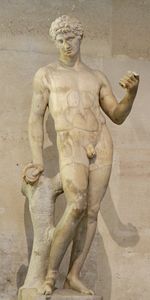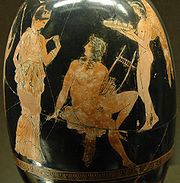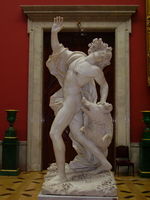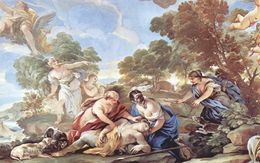Adonis
| Religions of the Ancient Near East |
|---|
|
|
Adonis (Greek aδωνις lord), is a figure with West Semitic antecedents, where he is a central cult figure in various mystery religions, who entered Greek mythology. He is closely related to the Cypriot Gauas[1] or Aos, Egyptian Osiris, the Semitic Tammuz and Baal Hadad, the Etruscan Atunis and the Phrygian Attis, all of whom are deities of rebirth and vegetation.[2] His cult belonged to women: the cult of dying Adonis was fully-developed in the circle of young girls around the poet Sappho from the island of Lesbos, about 600 BCE, as revealed in a fragment of Sappho's surviving poetry.[3]
Adonis was the young lover of Aphrodite. He was gored by a wild boar in the hunt and died in her arms after she came to him when hearing his groans. Upon death, she sprinkled his blood with nectar and the short-lived flower anemone, which takes its name from the wind which so easily makes it fall, was produced. The city Berytos (Beirut) in Lebanon was named after their daughter, Beroe, whom both Dionysus and Poseidon fell in love with. It is said that the blood of Adonis is what turns the Adonis River (modern Nahr Ibrahim in Lebanon) red each spring. Afqa is the sacred source where the waters of the river emerge from a huge grotto in a cliff 200 meters high. It is there that the myth of Astarte (Venus) and Adonis was born.
Adonis is one of the most complex cult figures in classical times. He has had multiple roles, and there has been much scholarship over the centuries concerning his meaning and purpose in Greek religious beliefs. He is an annually-renewed, ever-youthful vegetation god, a life-death-rebirth deity whose nature is tied to the calendar. His name is often applied in modern times to handsome youths.
Contents |
Origin of the cult

Adonis was certainly based in large part on Tammuz. His name is Semitic, a variation on the word "adon" meaning "lord" that was also used, as "Adonai", to refer to Yahweh in the Old Testament. When the Hebrews first arrived in Canaan, they were opposed by the king of the Jebusites, Adonizedek, whose name means "Lord of Justice". Yet there is no trace of a Semitic cult directly connected with Adonis, and no trace in Semitic languages of any specific mythemes connected with his Greek myth; both Greek and Near Eastern scholars have questioned the connection (Burkert, p 177 note 6 bibliography). The connection in cult practice is with Adonis' Mesopotamian counterpart, Tammuz:
"Women sit by the gate weeping for Tammuz, or they offer incense to Baal on roof-tops and plant pleasant plants. These are the very features of the Adonis cult: a cult confined to women which is celebrated on flat roof-tops on which sherds sown with quickly germinating green salading are placed, Adonis gardens... the climax is loud lamentation for the dead god."—Burkert, p. 177.
When the cult of Adonis was incorporated into Greek culture is debated: Hesiod made him the son of Phoenix, eponym of the Phoenicians, and his association with Cyprus is not attested before the classical era. W. Atallah[4] suggests that the later Hellenistic myth of Adonis represents the conflation of two independent traditions.
Adonis was worshipped in unspoken mystery religions: not until Imperial Roman times (in Lucian of Samosata, De Dea Syria, ch. 6 [5]) does any written source mention that the women were consoled by a revived Adonis. The third century BCE poet Euphorion of Chalcis in his Hyacinth wrote "Only Cocytus washed the wounds of Adonis".[6] Women in Athens would plant "gardens of Adonis" quick-growing herbs that sprang up from seed and died. The Festival of Adonis was celebrated by women at midsummer by sowing fennel and lettuce, and grains of wheat and barley. The plants sprang up soon, and withered quickly, and women mourned for the death of the vegetation god (Detienne 1972).
Birth and death of Adonis

Adonis' birth is shrouded in confusion for those who require a single, authoritative version. The patriarchal Hellenes sought a father for the god, and found him in Byblos and Cyprus, which scholars take to indicate the direction from which Adonis' cult had come to the Greeks. Pseudo-Apollodorus, (Bibliotheke, 3.182) considered Adonis to be the son of Cinyras, of Paphos on Cyprus, and Metharme. Hesiod, in a fragment, believes he is the son of Phoenix and Aephesiboea. In Cyprus, the cult of Adonis gradually superseded that of Cinyras [7]. Walter Burkert questions whether Adonis had not from the very beginning come to Greece with Aphrodite (Burkert 1985, p. 177).

Multiple versions of the birth of Adonis exist: The most commonly accepted version is that Aphrodite urged Myrrha to commit incest with her father, Theias, the King of Smyrna or Syria (which helps confirm the area of Adonis' origins). Myrrha's nurse helped with the scheme, and Myrrha slept with her father in the darkness. When Theias at last discovered this deception by means of an oil lamp, he flew into a rage, chasing his daughter with a knife. Myrrha fled from her father, and Aphrodite turned her into a myrrh tree. When Theias shot an arrow into the tree—or alternately when a boar used its tusks to rend the tree's bark—Adonis was born from the tree. This myth fits both Adonis' nature as a vegetation god and his origins from the hot foreign desert lands where the myrrh tree grew. (It was not to be seen in Greece.) As soon as Adonis was born, the baby was so beautiful that Aphrodite placed him in a closed chest, which she delivered for security to Persephone, who was also entranced by his unearthly beauty and refused to give him back. The argument between the goddess of love and the goddess of death was settled by Zeus, with Adonis spending six months with Aphrodite, who seduced him with the help of Helene, her friend, and six months with Persephone.[8]
Adonis died at the tusks of a wild boar, sent by either Artemis in retaliation for Aphrodite instigating the death of Hippolytus, a favorite of the huntress goddess, or Aphrodite's paramour, Ares.[9] As Aphrodite sprinkled nectar on his body, each drop of Adonis' blood turned into a blood-red anemone, and the river Adonis (modern Nahr Ibrahim) flowing out of Mount Lebanon in coastal Lebanon ran red, according to Lucian (chs. 6–9). Therefore, Persephone ultimately laid claim to Adonis as his shade was transported forever more to the Underworld. Lucian, who attributes the color of the river Adonis to siltation, adds "Nonetheless, there are some inhabitants of Byblos who say that Osiris of Egypt lies buried among them, and the mourning and the ceremonies are all made in honour of Osiris instead of Adon" [10]. Certainly there are many parallels with the myth of Osiris, encased in the coffin, imprisoned in the tree from which he issues forth.
"In Greece" Burkert concludes, "the special function of the Adonis cult is as an opportunity for the unbridled expression of emotion in the strictly circumscribed life of women, in contrast to the rigid order of polis and family with the official women's festivals in honour of Demeter."
The most detailed and literary version of the story of Adonis is in Book X of Ovid's Metamorphoses.
Cultural references to the rebirth mythology

The myth of the death and rebirth of Adonis has featured prominently in a variety of cultural and artistic works. Giovan Battista Marino's masterpiece, Adone, published in 1623, is a long, sensual poem, which elaborates the myth of Adonis, and represents the transition in Italian literature from Mannerism to the Baroque. Percy Bysshe Shelley wrote the poem Adonais for John Keats, and uses the myth as an extended metaphor for Keats' death.
Such allusions have continued to the present day. Adonis (an Arabic transliteration of the same name, أدونيس) is the pen name of a famous Syrian poet, Ali Ahmad Said Asbar, who was nominated more than once for a Nobel Prize for literature, including in 2006. His choice of name relates especially to the rebirth element of the myth of Adonis (also called "Tammuz" in Arabic), which was an important theme in mid-20th century Arabic poetry, chiefly amongst followers of the "Free Verse" (الشعر الحر) movement founded by Iraqi poet Badr Shakir al-Sayyab. Adunis has used the myth of his namesake in many of his poems, for example in "Wave I", from his most recent book "Start of the Body, End of the Sea" (Saqi, 2002), which includes a complete retelling of the birth of the god.
Modern association with physical beauty and youth

An extremely attractive, youthful male is often called an Adonis, often with a connotation of deserved vanity: "the office Adonis". The legendary attractiveness of the figure is referenced in Sarrasine by Honoré de Balzac, which describes an unrequited love of the main character, Sarrasine for the image in a painting of an Adonis and a castrato. The allusion to extreme physical attractiveness is apparent in the psychoanalytical Adonis Complex which refers to a body image obsession with improving one's physique and youthful appearance.
Bodybuilders use the expression "adonis belt" to refer to the two shallow grooves of the surface anatomy of the human abdomen running from the iliac crest (hip bone) to the pubis.
Church of the Nativity and Shrine of Adonis-Tammuz
According to some scholars, the Church of the Nativity in Bethlemen is built over a cave that was originally a shrine to Adonis-Tammuz.
The Church Father Jerome, who died in Bethlehem in 420, reports in addition that the holy cave was at one point consecrated by the heathen to the worship of Adonis, and a pleasant sacred grove planted before it, to wipe out the memory of Jesus. Modern mythologists, however, reverse the supposition, insisting that the cult of Adonis-Tammuz originated the shrine and that it was the Christians who took it over, substituting the worship of their own god.[11]
See also
- Adonai, (Hebrew): lord
- Adonia, feasts celebrating Adonis
- Adonis interpreted by R. Segal; a Jungian interpretation of the Adonis myth.
- Adonism
- Apheca
- Muscle dysmorphia, as part of Adonis Complex
Notes
- ↑ Detienne, Marcel and Lloyd, Janet (1994). The Gardens of Adonis: Spices in Greek Mythology, Princeton University Press, ISBN 978-0691001043 (p.137)
- ↑ See life-death-rebirth deity.
- ↑ The standard modern survey and repertory of Adomis in Greek culture is W. Atallah, Adonis dans la littérature et l'art grecs (Paris) 1966.
- ↑ Atallah 1966.
- ↑ "Lucian's De Dea Syria-Intro and Part One". Archived from the original on 2009-10-24. http://www.webcitation.org/5kmC8Bbyv.
- ↑ Remarked upon in passing by Photius, Biblioteca 190 (on-line translation).
- ↑ Atallah 1966
- ↑ Hamilton, 1942, 1969
- ↑ According to Nonnus, Dionysiaca 42.1f. Servius on Virgil's Eclogues x.18; Orphic Hymn lv.10; Ptolemy Hephaestionos, i.306, all noted by Graves. Atallah (1966) fails to find any cultic or cultural connection with the boar, which he sees simply as a heroic myth-element.
- ↑ "Lucian's De Dea Syria-Intro and Part One". Archived from the original on 2009-10-24. http://www.webcitation.org/5kmC8Bbyv.
- ↑ Marcello Craveri, The Life of Jesus, Grove Press (1967) pp. 35-36
References
- Burkert, Walter, 1985.Greek Religion, "Foreign gods" p 176f
- Detienne, Marcel, 1972. Les jardins d'Adonis, translated by Janet Lloyd, 1977. The Gardens of Adonis, Harvester Press.
- Frazer, James. The Golden Bough. (1890, etc.; recent edition: London: Penguin, 1996).
- Graves, Robert (1955) 1960. The Greek Myths (Penguin), 18.h-.k
- Kerenyi, Karl, 1951 The Gods of the Greeks pp 75–76.
- Theoi.com: Aphrodite and Adonis
- Hamilton, Edith 1942,1969 Mythology pg. 90-91
- Mahony, Patrick J. An Analysis of Shelley's Craftsmanship in Adonais. Rice University, 1964.
- O'Brian, Patrick. "Post Captain." Aubrey/Maturin series. W.W. Norton, pg. 198. 1994.